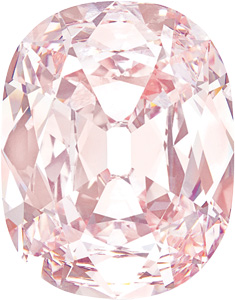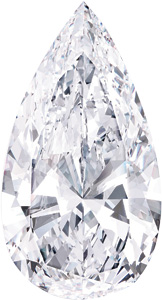|
Auctions
Rarity Rocks Auctions
The New York spring Magnificent Jewelry auctions delivered with strong sales and high totals for impeccable jewels.
By Amber Michelle
The stock market was soaring and gold prices were sinking as the spring jewelry auction season kicked off in April in New York City. Big rocks ruled the day at Christie’s, while beautiful, signed pieces from private collections reigned at Sotheby’s, with both auction houses garnering top dollar for irreplaceable gems and jewelry.
 |
| The Princie Diamond, a 34.65-carat, cushion-cut, fancy intense pink type IIa Golconda diamond sold at Christie’s for $39,323,750. |
The auction frenzy began at Christie’s, where the sale rang up $81,358,700, an astounding total for a New York auction. The presale estimate was $35 million and did not include the storied Princie Diamond, which was considered a “separate auction.” The 294-lot sale was 82 percent sold by lot and 91 percent sold by value. This total compares to the October 2012 sale that pulled in $49,993,175 and the April 2012 auction that tallied up $70,726,650.
This sale got a big boost from its top lot, The Princie Diamond, a 34.65-carat, cushion-cut, fancy intense pink type IIa Golconda diamond that sold to a deep-pocketed anonymous buyer for $39,323,750,* including the buyer’s premium, or $1,135,000 per carat. The presale estimate for The Princie was $35 million and the hammer price came down at exactly that number. Word on the street was that the consignor had been shopping The Princie around for the past two years with an asking price of $55 million. Dealers in the room — and others not at the sale but in the know about pink diamonds — were surprised that the stone didn’t sell for more, given the rarity of its size, color and history.
With little fanfare and no competition, the pink diamond sold quickly and decisively to a bidder on the phone manned by none other than Christie’s Managing Director and Head of Worldwide Jewelry François Curiel. The gem had an even, powder-puff pink color throughout and the soft, luminous glow that is the signature of Golconda diamonds. When held in the hand, one could feel the energy of The Princie’s history and the stories it holds in its memory.
The diamond traces its lineage back to the Nizam of Hyderabad in the 1700s, when a pink cushion-cut diamond weighing approximately 34 carats was acknowledged as part of his holdings. On March 17, 1960, the diamond was sold by another generation of the Nizam of Hyderabad at a Sotheby’s London auction. The gem was purchased by Van Cleef & Arpels (VCA) for 46,000 pounds, $128,000 at 1960 conversion rates, and according to records was still at VCA in1975. Shortly after its purchase at auction, VCA sent the diamond to its Paris store, where it was unveiled at a party at which the guests of honor were the luxury-loving Maharani of Baroda Sita Devi, who had a passion for jewels, and her 14-year-old son, the Prince of Baroda, Sayajirao Gaekwad, nicknamed “Princie.” It was from this term of endearment that the stone got its name. The Princie Diamond resurfaced again publicly for this auction.
The sale also boasted a selection of large white diamonds — between 20 carats and 30 carats — all of which sold for solid prices, but within their estimates. “The white diamond market and the jewelry market in general is doing very well for top-quality important jewels,” says Rahul Kadakia, head of jewelry, Christie’s Americas and Switzerland. “Collectors are willing to go the distance to acquire great things. The market is in a good place as long as prices are realistic. There is a lot of appetite at the right prices. What you can’t replace will make a lot of money.”
The rest of the sale was characterized by jewelry that sold swiftly at reasonable prices, mostly within their presale estimates.
 |
| A 74.79-carat D, VVS1, potentially flawless type IIa pear-shaped diamond sold at Sotheby’s for $14,165,000. |
The sale at Sotheby’s the next day featured very competitive bidding on jewelry from a number of private collections led by select pieces from the family of Jay Gould, who had built his fortune at the end of the nineteenth century as a financier, speculator and railroad developer. The six-piece Gould collection accounted for $7.9 million of the sale total as the incomparable jewels sold for top dollar.
This sale brought in $53,490,938, the highest-ever total for a spring sale of jewelry at Sotheby’s New York. The 397-lot sale was sold 82.4 percent by lot and 87.6 percent by value. This compares to the December 2012 sale that achieved $64,765,013 and the April 2012 sale, which scored $43,192,151.
The top-selling lot was a 74.79-carat, D, VVS1, type IIa, potentially flawless pear-shaped diamond, which sold for $14,165,000 or $189,397 per carat. There was high drama surrounding the sale of this stone, with multiple bidders competing for ownership. It came down to two potential buyers, one in China on the phone with Quek Chin Yeow, head of jewelry for Sotheby’s Asia, who was in New York for the auction, and another unknown buyer on the phone. The buyer in China had set a limit on what he was willing to pay, but still stalled the sale while trying to make up his mind. After a great deal of hemming and hawing, he dropped out and it looked like the other phone bidder would win the stone. However, there was an unexpected turn of events when a dealer in the room, who is part of the international trade, swooped in with the winning bid and scooped up the stone.
This diamond was consigned by a private collector who had purchased the gem at auction in 2001 for $4.3 million. The stone had been set as a simple pendant but was sold loose. Its graceful shape and precision cut gave it a beautiful sparkle and there was barely a hint of the bow tie that is so often seen in pear shapes. “We rarely get a diamond like that from a private collector and we were able to offer it at an amazingly attractive price, less than market value,” said Lisa Hubbard, chairman, North & South America, Sotheby’s international jewelry division.
White diamonds in general sold well at the sale and Gary Schuler, Sotheby’s
senior vice president
and director of the jewelry department, noted that diamond prices seem to have stabilized. “Prices were solid, but exceptional things brought exceptional prices. The 7.45-carat F, VVS2 Tiffany diamond ring sold for $473,000 and the 37.07-carat K, VS2 cushion cut sold for $2,285,000,” he said.
Still, the most active bidding at the auction — sometimes lasting several minutes for one item — came for vintage jewelry that is difficult if not impossible to find today. Collectors and dealers search for these pieces relentlessly as the demand grows and the supply dwindles. “If you put out something wonderful at attractive prices, they will come,” concluded Hubbard.
*All prices include buyer’s premium.Article from the Rapaport Magazine - May 2013. To subscribe click here.
|
|